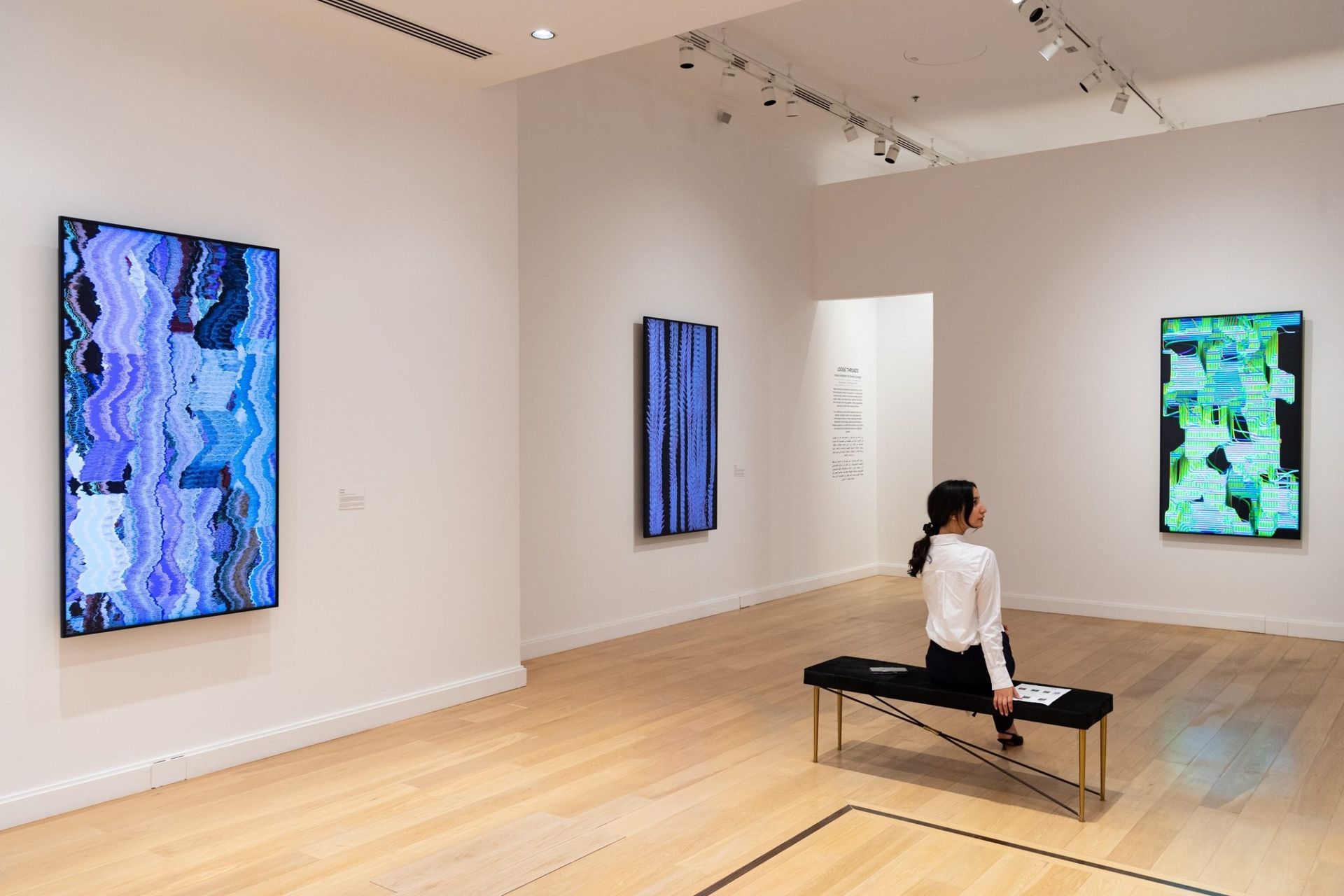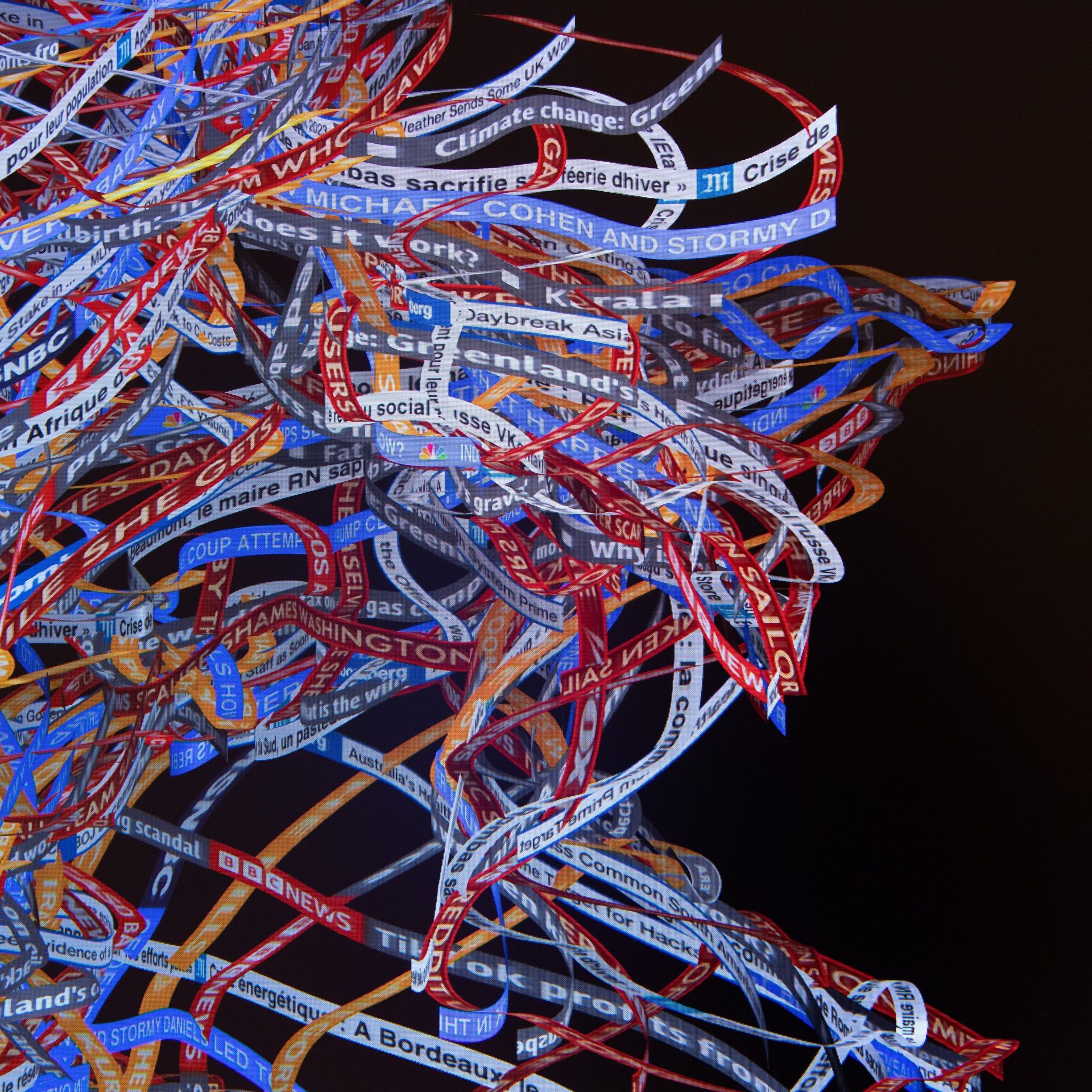
Loose Threads: A Solo Exhibition by Daniel Canogar
23rd January – 24th February 2023
Galloire Presents
Loose Threads
A Solo Exhibition
Daniel Canogar
Many historians consider the Jacquard loom as the first computer in history: the patterns in textiles were mechanically created via the binary code of punch cards. Today, our screens have replaced the fabrics from the past, stitching together cables, base plates, input ports, data flows, ones and zeros… The pieces in this exhibition explore the textile dimension of technology, weaving informational threads together in an attempt to process and visualize the vast amount of data that shapes our digitized present.
“Data surrounds us, and yet we can’t really see it in a way that is tangible, physical, and that allows us to wrap our minds around the expanding field of big data. We need to find ways of better understanding how data has infiltrated every aspect of our lives, so as to better harness it and use it in useful ways rather than be used by it. I believe art can help out in this regard. As an artist, I am not interested in data visualization but in using data to make art.”


Plexus demonstrates the artist’s earliest interest in textiles and craftsmanship: his hand is multiplied, filling the screen with a collective choreography reminiscent of mass production processes. Manual labor is disappearing. Potters, glass blowers or cabinetmakers, to name just a few, are dying trades, and with their dwindling presence long traditions refined through the centuries fade. Electronics, AI and the robotization of the manufacturing process erase the hand as a fabricating tool. Homo faber gives way to homo cyber. This key work represents a starting point for the subsequent pieces included in the show of the “dataworks” series, which incorporate generative behaviour: Works that constantly mutate, never repeating and created in real-time based on data.
In recent years, mobile devices have transformed our lives, encouraging overstimulation and an addictive need for constant updates. In this media environment, extreme visions of reality—fake news, conspiracy theories and apocalyptic alarmism—have taken root. The resulting informational indigestion generates a crisis of the perception of reality. The “dataworks” capture this overwhelming amount of information and transform it into semi-abstract animations in a constant state of flux, a gesture that helps to process the disjointed information we receive.


In Ripple, for example, we see real-time images from major news outlets cascading down the screen, leaving behind a trail that covers and obscures previous news items: The internet has created an unrelenting flow of information. Previous news consumption rituals including purchasing the daily paper or the concentrated viewing of television’s nightly news have been disrupted by a perpetual flow of information that leaves us in a constant state of update anticipation. Ripple attempts to capture the constant stream of information of our digital world via a generative artwork, using abstraction to capture the social fabric created by the incessant flow of electronic news. The final result visually is an abstract and dynamic composition echoing endless folds of fabric, from the ripples of never-ending news stories.
Whilst in Billow, the materiality of textiles is represented by sculptural, curved LED screens that challenge the orthodox rectangular flat shape and provide a new corporeality to the technological device. These works evoke fabrics unfolding through the exhibition space whilst all the time responding to viral data collected across Google platforms. Colors within the animation are determined by how “hot” or popular a specific topic becomes, the more viral the search is online, the warmer the tones become. Popular queries from each day appear momentarily as overlaid text before dissolving into a smoky abstraction. Their lingering forms generate illusions of interlaced imagery. The data-sphere is a driving force of society and the economy, despite its invisible nature. This lack of visibility can make it difficult to comprehend how information affects daily life. Billow attempts to expose the hidden threads of data networks.


Finally, the Pixelweaver series has been created with an algorithmic tool that simulates the workings of a loom and enhances the creation of infinite combinations of warp, weft and information. In Chyron is rendered with threads of news channel tickers (from the likes of CNN to Al Jazeera and Reuters), intertwining like a large frayed fabric, a tangle that evokes the fragile and at times unstable balance of an information ecosystem created from disparate and even conflicting sources. Abacus, uses stock-market data to create a mechanical composition reminiscent of a loom. The artwork reformulates the perforated ticker tape which was the main financial communication media since the end of 19th century. The quotations from each index appear like stripes intertwined, turning into the warp and weft of a fabric that never ceases to change. Túnica is a generative digital fabric created with the names of those who were born and died in the Community of Madrid between 2020 and 2021. The names are embossed on silver and gold stripes that intertwine: the weft for the births and the warp for the deceased. Túnica, a tribute to COVID victims during that time, is inspired by the funerary gauzes of pre-Columbian cultures.
The entire exhibition questions wide ranging aspects of the modern world, from financial fragility to life and death in the face of a global pandemic. Throughout their mantric and meditative aesthetics, the artworks seek to provide a calm and reflective experience amid the turbulent reality we live in, allowing us to better process some of the fundamental issues of our times.





